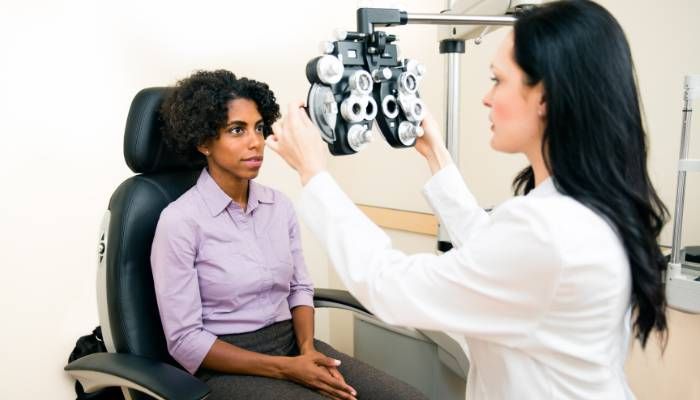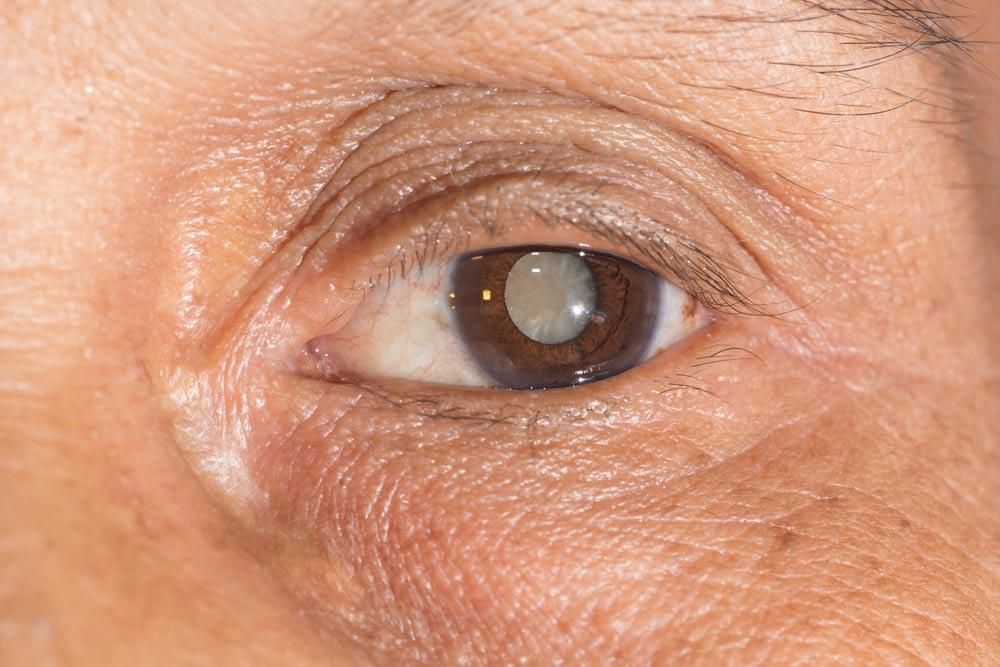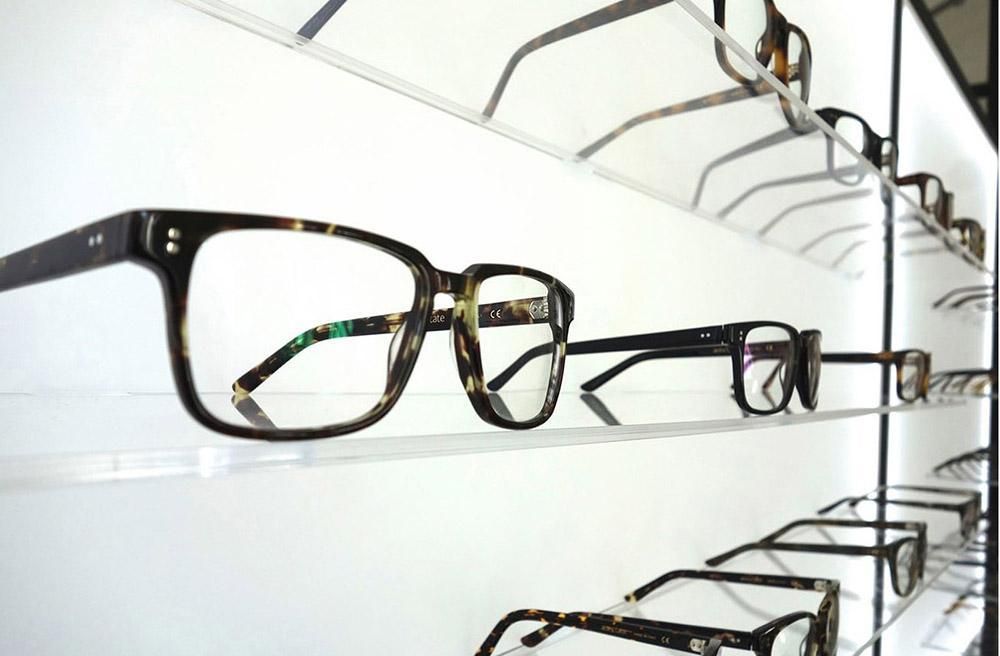The Benefits Of Comprehensive Eye Exams
Having comprehensive eye exams is an important part of maintaining good vision and overall health. It provides a thorough evaluation of the eyes and surrounding structures, which often reveals problems that can be addressed early on in order to prevent long-term damage or even blindness. This article will explore the various benefits associated with having regular comprehensive eye exams.
The first benefit is that it allows for early detection of potential issues. An optometrist or ophthalmologist will use specialized equipment during an exam to check for any existing visual changes, as well as signs of underlying conditions such as glaucoma and macular degeneration. Early diagnosis of these issues can help protect against complications down the road by providing faster treatment options.
Another advantage of getting regular eye exams is that they enable appropriate eyewear prescriptions to be updated if necessary. As individuals’ eyes age, their prescription may need to be modified accordingly in order to ensure clear vision. Additionally, proper eyeglasses or contact lenses provide protection from ultraviolet rays, reducing risk factors related to developing certain types of cancers around the eyes or other areas affected by UV radiation exposure.
In conclusion, there are numerous advantages to obtaining comprehensive eye exams regularly throughout life. With early detection and preventive measures taken where possible, individuals can improve their chances of maintaining healthy vision into adulthood and beyond.
What Is A Comprehensive Eye Exam?
A comprehensive eye exam is a medical procedure that evaluates the health of an individual’s eyes. During this process, an optometrist or ophthalmologist will assess various aspects of vision and determine how well someone can see. Additionally, they may use specialized equipment to detect any potential problems in the structure of the eye, such as glaucoma or cataracts. The purpose of a comprehensive eye exam is to identify any visual impairments and provide treatment if necessary.
The first step of a comprehensive eye exam typically involves testing for visual acuity, which measures how clearly one can see objects at different distances. This may be done using charts with letters or symbols on them that are designed to test specific areas of sight. After this initial assessment has been completed, other tests may be conducted depending on the patient’s age and symptoms. These could include checking color vision, depth perception and peripheral vision, among others.
In some cases, additional tools might be used during a comprehensive eye exam to further evaluate the condition of the eyes. For example, tonometry is often employed when assessing intraocular pressure levels while retinoscopy helps measure refractive errors like nearsightedness or farsightedness. Finally, digital imaging techniques such as OCT scans allow doctors to get detailed pictures inside the eyes so they can better diagnose any issues present there.
Overall, it is important for individuals to receive regular check-ups from their optometrists or ophthalmologists in order to maintain healthy vision and catch any potentially serious conditions early on before they become more difficult to treat effectively. Comprehensive eye exams offer numerous benefits for protecting our sight and should not be neglected by anyone who wishes to preserve clear vision into adulthood and beyond.
Why Should I Have An Eye Exam?
Having an eye exam is important for maintaining good vision and overall health. Comprehensive eye exams, in particular, provide a comprehensive view of one’s ocular status and can detect any issues that may require treatment or management. It is recommended that adults have their eyes examined every two years to keep up with changes in the visual system and ensure proper care.
Comprehensive eye exams are beneficial as they allow for early detection of potential problems such as glaucoma, diabetic retinopathy, cataracts, age-related macular degeneration (AMD), and other conditions. In addition, it provides insight into how well the eyes work together to produce clear images when looking at objects far away or closeup. A comprehensive eye exam can also help assess the need for corrective lenses if eyeglasses or contact lenses are required for optimal vision performance.
Moreover, having regular comprehensive eye exams helps maintain healthy eyes over time by ensuring proper diagnoses and treatments when needed. Many optometrists will use specialized tests during a comprehensive eye exam which allows them to gain detailed information about the patient’s vision and diagnose any underlying issues more accurately than a basic checkup would provide. With this knowledge, doctors can then tailor specific treatment plans accordingly based on what is best suited to each individual case.
Overall, getting a comprehensive eye exam is essential for safeguarding against potentially serious ocular diseases while simultaneously preserving quality vision health now and in the future. It is therefore advised that individuals take advantage of these examinations even if there are no current signs of issue because preventive maintenance can go a long way towards protecting vision health down the road
What Tests Are Included In A Comprehensive Eye Exam?
A comprehensive eye exam is a thorough examination of the eyes and visual system. It evaluates vision, detects diseases and abnormalities, identifies risk for future problems, and assesses the overall health of the eyes. During this type of exam, certain tests are conducted to ensure that all aspects of ocular health have been addressed.
The most common test included in a comprehensive eye exam is refraction or testing for glasses or contacts prescription, which determines how well your eyes focus light rays onto the back of your retina. Other tests may include checking eye muscles and binocular vision balance; assessing depth perception; determining pupil size response to light; evaluating eye pressure with tonometry; examining peripheral fields (side vision); assessing color vision; measuring corneal curvature using keratometry; conducting slit lamp biomicroscopy to examine eyelids, lashes, lens thickness and surface irregularities within the front portion of the eye; looking for signs of cataracts during a dilated fundus evaluation by an ophthalmologist or optometrist; documenting retinal nerve fiber layer thickness with optical coherence tomography (OCT) imaging when indicated as part of glaucoma screening or management protocol; and taking photographs inside the eye such as macular photography when necessary for diagnosis and treatment monitoring.
These procedures provide vital information about one’s overall eye health and can detect issues like diabetic retinopathy, macular degeneration, dry eyes syndrome, cataracts, glaucoma and more before they become serious threats to sight. Having regular comprehensive exams allows patients to maintain optimal visual acuity over time while also providing peace-of-mind knowing their eyes are healthy.
How Often Should I Have A Comprehensive Eye Exam?
A comprehensive eye exam is a thorough checkup of the eyes, including tests to assess vision and detect any eye conditions or diseases. It is recommended that adults have yearly comprehensive eye exams to ensure they remain healthy and can see clearly.
The frequency at which an individual should receive comprehensive eye exams depends on several factors. Age is one such factor; children may require more frequent visits than adults due to their developing vision. Additionally, medical history plays a role in how often an individual needs a comprehensive eye exam. Those with certain underlying health conditions, such as diabetes or high blood pressure, may need additional screenings compared to those who are healthy. Furthermore, if symptoms occur between appointments – such as blurry vision or headaches – it is important for individuals to make an appointment with their optometrist right away instead of waiting until their regularly scheduled visit.
Overall, understanding when and why a comprehensive eye exam is necessary helps individuals maintain good ocular health. Regular examinations help identify issues early and thus reduce the risk of permanent damage occurring down the line. Knowing when these examinations should take place allows individuals to plan accordingly and book appointments with their optometrists at appropriate intervals throughout the year.
Who Should Have A Comprehensive Eye Exam?
A comprehensive eye exam is a type of medical examination that assesses the overall health and function of an individual’s eyes. It can be used to diagnose vision problems, detect diseases such as glaucoma or cataracts, and monitor general eye health. Due to its wide range of benefits, there are certain groups who should consider having this type of exam on a regular basis.
First and foremost, those with known vision issues or chronic conditions affecting their eyesight should have a comprehensive eye exam at least once every two years. This includes individuals suffering from diabetes-related retinopathy or macular degeneration, as well as patients with high myopia (nearsightedness) or hyperopia (farsightedness). Additionally, people over 65 may find it beneficial to get checked more often due to age-related changes in their eyesight.
Secondly, anyone engaged in activities which require intense use of the eyes – such as driving long distances regularly – could benefit from getting a comprehensive eye exam annually. The same goes for people whose hobbies include reading small print or working on computers for extended periods; these individuals might want to schedule an appointment with an optometrist if they experience any blurred vision or other visual disturbances while engaging in those tasks. Lastly, those who wear glasses or contact lenses should also attend regular checkups since prescription eyewear needs periodic updates depending on how quickly one’s vision changes over time.
In summary, having a comprehensive eye exam is recommended for many different types of individuals: those with existing ocular disorders or conditions like diabetes; seniors over 65; frequent drivers; readers and computer users; and wearers of prescription eyewear. Regular visits to an optometrist can help ensure that an individual’s eyes remain healthy throughout their lifetime.
What Are The Benefits Of Wearing Corrective Lenses?
The benefits of wearing corrective lenses are numerous, and can improve the quality of life for individuals with vision related disorders. Corrective lenses can help to reduce eye strain and headaches, as well as enhance visual clarity when engaging in activities such as reading or driving. Additionally, corrective lenses can help to protect against long-term damage caused by underlying ocular conditions.
The use of corrective lenses has been found to be beneficial in a wide range of scenarios. Those who work at a computer frequently may experience less eyestrain while using their glasses compared to those without them; likewise, athletes participating in sports requiring distance vision often report improved performance after obtaining prescription eyewear. Furthermore, contact lenses offer more mobility than traditional frames and do not interfere with peripheral vision due to their size.
Corrective lenses have also been shown to improve self-image and confidence among wearers by providing an aesthetically pleasing look that is both fashionable and comfortable. By providing clear vision, these devices support daily activities such as learning at school or performing on stage, allowing users to focus on important tasks without worrying about blurred images or impaired sight. In this way, corrective lenses play a vital role in promoting overall wellness for people with visual impairments.
Wearing the correct type of lens for individual needs provides many advantages that extend beyond improved vision alone—including increased safety and enhanced lifestyle satisfaction–making it essential for those living with poor eyesight to receive regular comprehensive eye exams so they can successfully utilize the full potential of corrective lens technology.
What Is The Difference Between A Comprehensive Eye Exam And A Refraction Exam?
A comprehensive eye exam is a comprehensive evaluation of the eyes, including vision testing and ophthalmologic assessment. A refraction exam is solely an assessment of visual acuity for determining eyeglass prescriptions.
During a comprehensive eye exam, the patient’s medical history will be discussed to determine any risk factors that may affect the health of their eyes. This includes age-related diseases such as Glaucoma or Macular Degeneration. The doctor will also check pupils, eye movements and peripheral vision in addition to visual acuity with an automated machine or manually using cards with symbols on them. If necessary, dilation drops are used to examine the inside of the eyes for signs of disease or damage.
In contrast, during a refraction exam, there is no discussion about medical history; instead it focuses solely on assessing nearsightedness (myopia), farsightedness (hyperopia) as well astigmatism. An instrument called phoropter is typically used which contains lenses that allow the optometrist to assess how light rays focus when they enter into your eyes. After several different lens combinations have been tested by presenting various letters or pictures at varying distances away from you, your optimal prescription strength can then be determined by comparing what has been seen most clearly at each distance presented.
It should be noted that while both exams involve assessments made through lenses and instruments, they differ in terms of scope and purpose—the former being more general whereas the latter only tests for corrective lenses needs. Therefore depending on one’s individual circumstances either type could potentially provide greater benefit than the other alone.
What Information Will My Doctor Glean From A Comprehensive Eye Exam?
A comprehensive eye exam is an important part of maintaining good vision health. During a comprehensive eye examination, ophthalmologists and optometrists will be able to assess the overall health of the eyes, detect any abnormalities or diseases, and prescribe corrective lenses if needed. Through this type of exam, practitioners can obtain a wealth of information about a patient’s visual system.
The first step in a comprehensive eye exam involves determining how well the patient’s eyes focus on near and distant objects. This process may include using sophisticated instruments such as retinoscopes that measure refractive errors like myopia (nearsightedness) or hyperopia (farsightedness). Additionally, doctors will use automated machines to evaluate how much light passes through the cornea and lens before it reaches the retina. These tests help determine whether glasses are necessary for clear vision correction or contact lenses should be prescribed instead.
Finally, during a comprehensive eye exam, doctors also check for signs of glaucoma by measuring intraocular pressure as well as checking for cataracts by examining the size and shape of the pupil under different lighting conditions. They may also examine either side of the retina through dilated pupils with special devices looking for diabetic retinopathy or macular degeneration. All these measures combined allow them to accurately diagnose potential problems early on so they can provide patients with appropriate treatments right away before further complications arise.
In addition to providing valuable medical information concerning current vision status, comprehensive exams also serve as an opportunity for physicians to educate their patients on measures they can take at home to protect their sight such as wearing sunglasses when outdoors to reduce sun exposure damage or avoiding smoking which affects blood circulation in the eyes.
What Are The Early Signs Of Vision Problems?
When it comes to eye health, recognizing the early signs of vision problems is essential for preventing long-term damage. Comprehensive eye exams are designed to provide a detailed assessment of an individual’s vision and screen for potential issues that may not be obvious without professional intervention. By understanding the various warning signs associated with conditions such as nearsightedness, farsightedness and astigmatism, patients can take preventative measures before they experience more serious effects on their sight.
The most common sign of a vision problem is blurred or distorted vision when looking at objects up close or far away. This could indicate myopia (nearsightedness) if distant objects appear blurry while nearby ones remain in focus and hyperopia (farsightedness), if the opposite occurs. Other symptoms include frequent squinting, sensitivity to bright lights, headaches due to eyestrain and double vision. Additionally, some individuals might find themselves getting tired quickly when reading small print or having difficulty seeing clearly in low light environments.
For those who wear glasses or contact lenses, changes in prescription strength over time can signify underlying issues which need further evaluation from an optometrist or ophthalmologist. It is important to note that many age-related conditions like cataracts might present no visible symptoms initially but worsen steadily overtime unless treated appropriately by medical professionals. Therefore regular comprehensive eye examinations are recommended even if patients do not report any concerning visual changes in order to detect subtle alterations early on and get timely treatments for better outcomes.
In summary, being aware of the earliest indications of possible sight impairments will help individuals seek necessary interventions promptly thus minimizing risks related to failing eyesight due to neglected complications. Moreover, periodic visits to an optometrist should be scheduled regardless of whether there are apparent problems since certain disorders might progress unnoticed until it becomes too late for effective management strategies
Are There Any Special Considerations For Children Regarding Eye Exams?
Eye exams are important for everyone, but they are especially essential for children. To ensure that a child’s vision is developing properly and to detect any potential issues early, it is recommended that they receive comprehensive eye examinations regularly. In addition to assessing visual acuity and the ability of eyes to work together as a team, pediatric comprehensive eye exams should also assess the alignment of the eyes, examine the overall health of both eyes, check color discrimination abilities, evaluate depth perception, and look for signs of diseases or other abnormalities in the retina.
There are several special considerations when performing an eye exam on a young patient. For example, due to their limited communication skills and lack of understanding regarding how glasses or contact lenses can help them see better, it can be difficult for optometrists to accurately diagnose problems with younger patients. Additionally, some parents may not understand why regular visits are necessary or fail to bring their children in even if there have been no apparent changes in behavior or performance at school. Therefore, it is important for practitioners to explain the importance of preventive care and provide guidance on identifying potential warning signs such as squinting during close-up activities like reading or sitting too close to watch television.
It is equally important that an appropriate environment be created so that a child feels comfortable throughout their entire visit. A positive experience will encourage good habits from an early age while helping alleviate any anxieties related to future visits; this includes having toys available and explaining each step of the examination before beginning. By taking these factors into account when conducting eye exams on young patients, providers can ensure that all bases are covered while providing quality care in order maximize effectiveness of diagnosis and treatment plans.
What Is The Cost Of A Comprehensive Eye Exam?
A comprehensive eye exam is an important part of preserving one’s vision and overall well-being. As such, it is essential to understand the cost associated with this type of medical service.
The exact price of a comprehensive eye exam varies depending on several factors, including provider location and insurance coverage. Generally speaking, however, patients can expect to pay anywhere from $50-$200 for a full exam that includes tests for nearsightedness and farsightedness as well as other assessments like visual field testing and pupil dilation. It may also be necessary to purchase glasses or contact lenses after the visit; these costs are not typically included in the initial fee charged by the practitioner.
When determining how much money to set aside for a comprehensive eye exam, prospective patients should consider additional expenses related to follow-up appointments if needed. Depending on individual circumstances, some providers may suggest multiple visits over time to monitor changes in vision or review results from certain tests. These extra charges could increase total costs significantly so it pays to ask about potential fees upfront.
In order to ensure affordability and access, many optometrists offer discounts for cash payments or provide payment plans for those without insurance coverage. Additionally, most states have programs available that can help cover some or all of the expense for low-income individuals or families who meet certain eligibility requirements. Researching local resources is recommended before committing to any financial arrangements with a healthcare provider.
What Are The Benefits Of A Comprehensive Eye Exam?
A comprehensive eye exam is an important health practice which can provide multiple benefits to the patient. During a comprehensive eye exam, the optometrist will evaluate vision acuity as well as assess overall ocular health. Moreover, they are able to detect any potential issues that may be indicative of serious medical conditions. As such, it is recommended by experts that people get regular comprehensive exams in order to maintain their visual and general wellbeing.
The most significant benefit of a comprehensive eye exam is early detection of potentially dangerous diseases or conditions before any symptoms become noticeable. For example, during an eye exam, optometrists are able to identify signs of diabetes, high blood pressure and even strokes due to changes in the retinal tissue. This allows for early diagnosis and treatment which could prevent long-term complications or even death if left untreated. Additionally, these tests can also detect brain tumors or other neurological defects which require intervention from medical professionals at the earliest possible time.
Furthermore, having a comprehensive eye exam on a consistent basis can lead to better management of existing ocular conditions such as glaucoma or astigmatism. Regular monitoring ensures that current treatments are effective and necessary adjustments can be made if needed; this helps reduce the risk of further damage caused by insufficiently treated ailments. Lastly, patients who regularly have their eyes tested tend to experience improved clarity in vision compared those who do not keep up with scheduled visits; this leads to increased confidence when driving or participating in activities where clear sight is paramount for safety reasons.
In summary, there are numerous advantages associated with getting regular comprehensive eye exams beyond simply ensuring good vision quality; these include early detection of serious illnesses as well as better management of existing ocular problems leading to reduced risks and improved overall performance.
Are There Any Potential Risks Of A Comprehensive Eye Exam?
Eye exams are an important tool for maintaining overall health, and a comprehensive eye exam is particularly useful in detecting potential problems. However, as with any medical procedure, there can be risks associated with a comprehensive eye exam. It is therefore important to understand the possible risks of this type of examination before making the decision to have it performed.
The most common risk associated with a comprehensive eye exam involves discomfort or irritation caused by the drops used to dilate the pupils during the test. These drops may make your eyes feel scratchy or burn briefly after they are administered. Additionally, you may experience blurry vision that results from dilation of the pupils; however, this should resolve within several hours after completion of the exam.
More serious risks include side effects from medications given during certain tests such as tonometry, which measures intraocular pressure within the eyeball. Medications used in tonometry testing may cause systemic reactions including dizziness and nausea if not properly monitored. Other rare but potentially dangerous complications could arise if contact lenses were worn inappropriately during a fitting process or if an instrument was accidentally inserted too deeply into one’s eye while measuring its curvature.
Overall, while there are some risks associated with having a comprehensive eye exam, these tend to be minor and short-lived when compared against the benefits of early detection of vision issues or other underlying conditions that might otherwise remain undiagnosed without regular checkups. Understanding all aspects of a comprehensive eye exam will help ensure both safety and successful outcomes related to better ocular health and improved quality of life over time.
What Should I Expect During A Comprehensive Eye Exam?
A comprehensive eye exam is a thorough evaluation of an individual’s vision and ocular health. During the exam, a series of tests will be conducted to assess visual acuity, refractive error, ocular motility or movement abilities, intraocular pressure (IOP), and other aspects of the eyes. Preparation for this type of examination may vary depending on the patient’s age; however, some general guidelines can help ensure that the appointment is successful.
Prior to arriving at the clinic for a comprehensive eye exam, patients should bring their eyeglasses and/or contact lenses if they are using them regularly. It is also important to check with insurance providers before scheduling an appointment to determine what types of services may be covered. Additionally, it is beneficial for individuals to make note of any changes in vision or new symptoms prior to the visit so these issues can be discussed during their consultation.
During a comprehensive eye exam, both distance and near vision will be tested by asking questions about letters displayed on a chart. An optometrist or ophthalmologist may also use devices such as phoropters and retinoscopes which measure refraction values and pupillary reflexes respectively. To evaluate IOP levels, tonometry tools might also be used which involve blowing air into each eyeball or touching it lightly with an instrument called a tonometer. Depending on results from these assessments additional screenings could occur including imaging studies like optical coherence tomography (OCT) scans or corneal topographies.
At the end of the visit, patients will receive guidance based on findings from all exams conducted throughout their session along with instructions for follow-up care if necessary. The clinical team present during the appointments may review lifestyle factors such as diet and exercise habits that have bearing on overall ocular health as well as discuss appropriate methods for managing current symptoms and preventing future complications related to vision loss or impairment.
What Should I Bring To My Eye Exam Appointment?
When preparing for a comprehensive eye exam, it is important to know what should be brought with you. An appointment at the optometrist’s office may require certain items in order to get the most out of your visit. Understanding what should and should not be taken into account can help ensure an optimal experience.
To start, individuals attending their eye exam should consider bringing any previous eyeglasses or contact lenses that have been used within the past year. This will allow the optometrist to better assess visual acuity as well as compare changes since last seen. Furthermore, if there are any current vision problems being experienced they can be discussed in detail during this time.
In addition to eyewear, patients would also benefit from bringing along their health insurance information and a list of medications currently being taken. A full understanding of all medical conditions helps doctors provide more accurate diagnoses and treatment plans if needed. It might also be useful to bring along a pair of sunglasses and hat due to possible exposure to bright lights while performing tests on the eyes.
By gathering these necessary components ahead of time, patients can make sure their appointment goes smoothly and efficiently throughout its entirety. Having everything prepared beforehand allows for more one-on-one time between patient and doctor without having to worry about forgetting something crucial for diagnosis or treatment planning purposes. Taking care when deciding which materials need to be included ensures each individual gets the best results out of their comprehensive eye exams.
Conclusion
The importance of comprehensive eye exams cannot be overstated. They are the best way to detect glaucoma, as well as other conditions that can lead to vision loss. Non-invasive tests may also prove useful for detecting potential problems with the eyes. Comprehensive eye exams at locations such as Fishkind, Bakewell, Maltzman & Hunter Eye Care and Surgery Center, are usually covered by insurance and special considerations should be taken into account when it comes to elderly people’s visual health. Furthermore, contact lens wearers must go through a more extensive exam than those who do not wear lenses in order to ensure proper fit and safety.
In conclusion, undergoing a comprehensive eye exam is paramount in ensuring good vision and preventing future complications or diseases from arising due to undetected issues with one’s eyesight. It is important that all individuals make sure their vision remains healthy throughout their lives, no matter what age they are at or if they choose to wear contacts or glasses. Doing so will bring about many benefits such as improved quality of life and greater independence; therefore, it is highly recommended that everyone have regular checkups regardless of any pre-existing ocular conditions.
FAQs
What Type Of Eye Exam Is Best For Detecting Glaucoma?
Comprehensive eye exams are important to detect any issues with vision, and they can be used to diagnose potentially serious conditions such as glaucoma. Glaucoma is a progressive disease that damages the optic nerve, which means regular screening is essential for early detection. The type of exam best suited to detect glaucoma depends on the patient’s risk factors and health history.
Ophthalmologists often use tonometry tests during comprehensive eye exams in order to measure pressure inside the eyes. This test helps them determine if there is an increase in intraocular pressure (IOP), which could indicate the presence of glaucoma or other diseases impacting the eyes. Tonometry tests may include applanation tonometers, noncontact tonometers, rebound tonometers, pneumatic tonometers, and Schiotz tonometers.
It is also important for ophthalmologists to consider other components when assessing a person’s risk for glaucoma. These components might include medical history (such as age and family history) as well as results from visual acuity testing, gonioscopy examination, slit-lamp photography imaging, optical coherence tomography scans, dilated fundus examinations, and corneal thickness measurements. By taking all these aspects into account, ophthalmologists can make more informed decisions about further diagnostic procedures or treatments needed to identify or manage glaucoma or other eye disorders.
In addition to making sure patients receive appropriate screenings at their routine checkups, it is recommended that people who have a higher risk of developing glaucoma seek additional screenings by qualified professionals every one to two years depending on their specific circumstances. This will help ensure that any changes in IOP levels are quickly detected so timely action can be taken before irreversible damage occurs due to untreated glaucoma.
Are There Any Non-Invasive Tests Available For Eye Exams?
Eye exams are an essential part of preventive healthcare for many, and it is important to consider the type of eye exam that best suits a person’s needs. Comprehensive eye exams may provide several benefits in terms of preventive care. One question concerning comprehensive eye exams is whether there are any non-invasive tests available.
Non-invasive tests involve testing without breaking the skin or entering inside one’s body. When considering examinations on eyes specifically, this means avoiding contact with the cornea and inner structures such as the lens. Non-invasive tests can include imaging techniques such as ocular coherence tomography (OCT), which creates high resolution images of specific regions within the eye; optical coherence tomography angiography (OCTA), which maps changes in retinal blood vessels; fundus photography, which captures digital images of the retina; and visual field testing, which measures peripheral vision using automated technology. All these tests collect data from outside parts of the eye and do not require direct contact with its internal components.
The use of non-invasive testing has been found to be effective in identifying various conditions including glaucoma, macular degeneration, diabetic retinopathy, and other diseases related to age and lifestyle choices. Some studies have also suggested that OCTs may detect early signs of glaucoma before traditional methods due to their ability to capture detailed structural information about cells located deep within tissues. This detail allows doctors to make more accurate diagnoses than what was possible with older technologies. Therefore, non-invasive tests tend to be a valuable tool when conducting comprehensive eye exams since they reduce risk while providing useful diagnostic information.
In summary, non-invasive tests offer great potential for those undergoing comprehensive eye exams by reducing risk factors associated with invasive procedures while still providing detailed results for diagnosis purposes. These types of tests allow physicians greater insight into potential concerns regarding a patient’s vision health without having to break through protective layers around sensitive areas like the cornea or lens.
Are Comprehensive Eye Exams Covered By Insurance?
The importance of comprehensive eye exams should not be underestimated. Regular check-ups can help diagnose or prevent various vision problems and diseases such as glaucoma, cataracts, macular degeneration, amblyopia and diabetic retinopathy. Given the potential benefits of these examinations, it is important to know whether they are covered by insurance.
In most cases, comprehensive eye exams are included in health insurance plans that include vision coverage. However, the level of coverage may vary based on provider and plan type. For example, some providers may only cover a portion of the cost for an exam or may require a co-payment from patients. Additionally, certain tests may also fall outside of what is typically covered under these policies. Therefore, it is advisable to contact your insurer prior to scheduling an appointment to determine if you have adequate coverage for a comprehensive eye exam.
Understanding the terms and conditions of one’s individual policy will ensure there are no surprise costs associated with the examination. It can also help individuals get access to necessary services in order to maintain their overall ocular health and well-being over time. Furthermore, more expensive procedures like corrective lenses or surgery might potentially be covered depending on the specific policy details so it pays off to find out exactly what kind of vision care benefits are available through an insurance provider before making any decisions about treatment options.
Are There Special Considerations For Older Adults When It Comes To Eye Exams?
The importance of comprehensive eye examinations for older adults cannot be overstated. It is important to ensure that the elderly receive quality vision care, as age-related changes can affect the eyes and cause various issues such as cataracts or glaucoma. Therefore, it is essential to understand any special considerations when scheduling an eye exam for this population group.
A complete eye examination should include tests that assess visual acuity and clarity, refraction, ocular motility and alignment, color vision and depth perception, pupillary responses and extraocular movements, slit lamp evaluation of anterior segment structures and intraocular pressure measurement. Furthermore, an assessment of the macula lutea structure by means of retinal photography or optical coherence tomography (OCT) may also be necessary in some cases.
In addition to these general aspects of a comprehensive eye exam, there are certain additional measures which must be taken into consideration for older patients due to their increased risk for developing age-related eye diseases like macular degeneration or glaucoma. These could include dilated fundus exams with dilation drops; gonioscopy; tonometry; repeat OCTs at different intervals if indicated; immunology laboratory testing; genetic testing; systemic evaluations from other specialists if needed; electrodiagnostic studies including pattern-electroretinograms (PERGs), multifocal ERGs (mfERGs); imaging techniques such as ultrasonography and computed tomography scans among others.
Overall, while most people benefit greatly from regular comprehensive eye exams regardless of age, those in the senior demographic require additional steps due to their susceptibility towards early onset conditions caused by aging. For this reason it is paramount that healthcare providers take special precautions when administering examinations on older adults in order to accurately diagnose any possible vision problems they may have developed over time.
Are Comprehensive Eye Exams Suitable For Contact Lens Wearers?
Comprehensive eye exams are comprehensive evaluations of an individual’s vision and ocular health, typically performed by an optometrist. They can include assessments for refractive error, depth perception, color blindness, and other forms of visual acuity. It is important to note that these exams are different from the screenings done at routine check-ups. As such, one may wonder if they are suitable for contact lens wearers.
In order to answer this question it is first necessary to understand how contact lenses work and their potential risks. Contact lenses correct refractive errors in the same way as glasses do; however, due to the fact that they make direct contact with the surface of the eye there is a risk of infection or irritation when not used properly. Moreover, some individuals have allergies that limit the types of contacts they can use safely.
Therefore, comprehensive eye exams are essential for contact lens wearers in order to assess both their level of vision correction needed and whether or not any particular type of contact lens will be safe for them to wear given any existing conditions or allergies. During a comprehensive exam an optometrist measures pupil size and range of motion as well as peripheral vision during which time he/she looks for signs of inflammation or allergic reactions on the cornea. They also evaluate tear production quality since dry eyes can lead to complications associated with wearing contacts over long periods of time. In addition, an optometrist will discuss proper cleaning techniques and safety guidelines related to wearing contacts so that patients know how best care for their vision health while using them.
Overall, whether someone wears contacts or not regular visits to an optometrist should be part of every person’s overall healthcare plan but particularly those who require corrective lenses like contact lenses must go through more extensive tests than others in order ensure both comfortability and optimal performance while using them.









